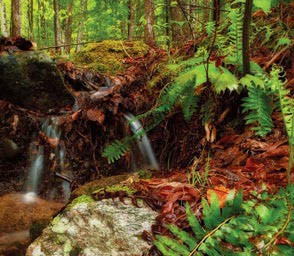Healthy forests play an absolutely vital role in moderating water movement over our landscape. Although forests cannot prevent large floods outright, they certainly do minimize the frequency, intensity, and extent of all flooding events, which in turn significantly reduces the damage to life and property that serious flooding causes. It’s yet another way in which forests work for us.
Water first enters our landscape in the form of rain, snow, sleet, fog, or hail. Forests may influence the occurrence and distribution of local precipitation, but their most significant contribution is in how forested watersheds receive and deal with all the water that falls on them. Forests absorb and reroute water – thereby diffusing its potentially damaging energy – before slowly releasing the water into seeps, ponds, lakes, rills, brooks, streams, and rivers. The net hydrologic effect of the forest is to delay and reduce the size of the flood peak.
Forested watersheds have complex canopies with varied densities of tree stems and branches, additional layers of non-tree vegetation, extensive root systems, deep, loose soils, and fluffy leaf litter. All of these features allow a large amount of water to infiltrate the soil and be absorbed – like a super-capacity sponge. A rainstorm can drop millions of tons of water on the land. When forest vegetation is present, leaves, stems, and downed woody debris intercept, absorb, and reduce the impact of both falling and running water. This allows the water to evaporate from plant surfaces, soak into the soil and its many pore spaces (animal burrows, decayed-root tunnels, or soil voids), or run off in a gradual manner. Soils in healthy forests are particularly porous and absorbent and can hold staggering volumes of water.
Much of the water absorbed by forest soils is drawn up by plant roots and transpired, moving back to the atmosphere as water vapor. During the growing season this “evapotranspiration” reduces the amount of water in the soil; in some forests it removes as much as 70 percent of the incoming precipitation. This, in turn, renews the soil’s ability to absorb even more water.
Consequently – and luckily for us – streamflow responses in forested watersheds tend to be slow and small, and they occur predominantly via subsurface runoff. Indeed, forested watersheds yield lower peak flows and smaller volumes of runoff over a longer time than do nonforested land covers. Accordingly, flood damage in forested areas – and in areas downstream of them – is the smallest among all surface conditions. Forests also minimize soil erosion and landslides, and improve stream channel stability and water quality.
There are limits to the flood-mitigating effects of forests. When soils are fully saturated, any additional rainfall will run off the land, whether it is forested or not. Thus, forests can reduce peak flows from storms of short duration and lower intensity. They can downright prevent flooding that would otherwise occur in lesser storms and smaller watersheds particularly sensitive to rain events. They can minimize the damage from large storms. But they cannot prevent the major floods produced by storms of high intensity and long duration.
Clearly, our needs for abundant clean water and healthy forests are important issues for the 21st century, not only because forests provide critical raw materials for people and industries, but also because they are key factors in the normal functioning of the environment. Water and forests are two of the most profound natural forces on the planet, and they are closely linked. Without water, there are no forests. And without forests we are much more vulnerable to erosion and flooding.


